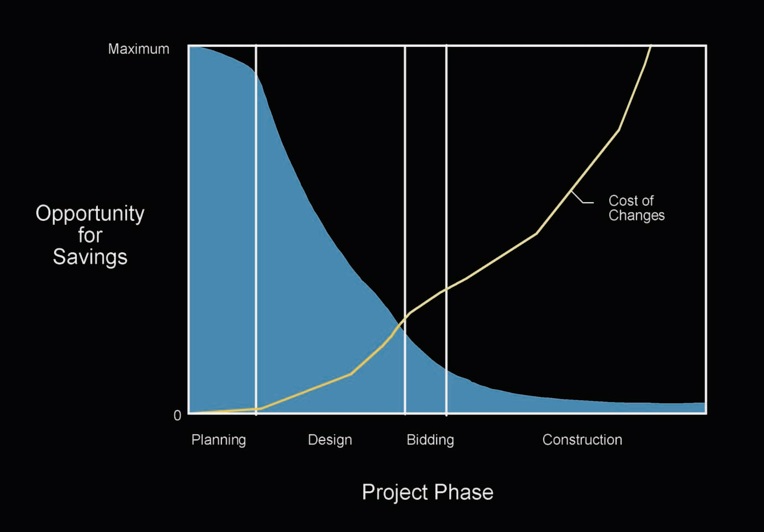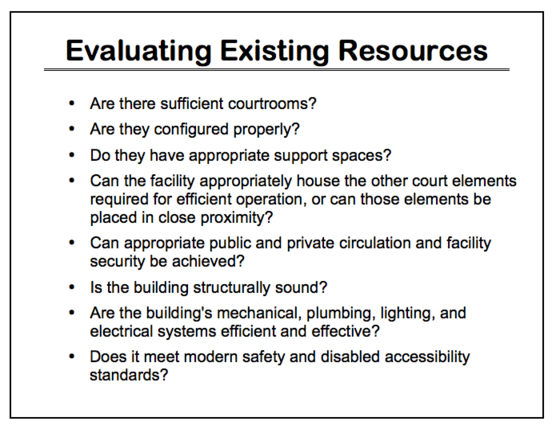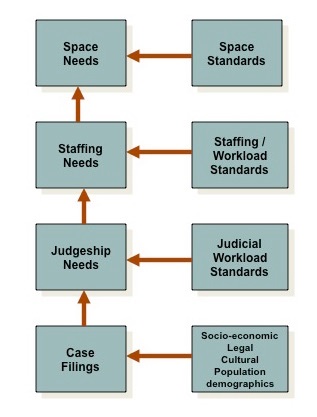Most projects commence with a recognition on the part of users and owners that existing facilities are inadequate. Evaluate deficiencies in the current facility early in the long-term planning process. Document and quantify existing conditions. (See Courthouse Facilities Checklist.)
 |
|
Cost Control Opportunities |
When discussions regarding facility improvements become serious, it is important to systematically explore options. While pre-design or planning activities as are sometimes viewed as unnecessary or duplicative of the work done by the architect during design, spending time and money on pre-design will assure that needs are properly identified. Because changes are costly, investment in pre-design and planning can save money.
It is difficult to overemphasize the importance of early planning. During this phase:
- Needs are assessed. Problems including overcrowding and operational obsolescence are identified and solutions sought.
- Master Planning and Architectural Programming define the building's occupants and total size; the building site is selected.
- Project budgets are established and funding options evaluated.
- Facility planning and design standards are set.
Planning lays the foundation for design. During this phase, changes can most readily and least expensively be accomplished.
There is no single appropriate standard that all court facilities must meet. Many jurisdictions operate facilities that represent compromises in some areas. Once an evaluation of physical, spatial, and operational characteristics has been conducted, then the use of existing resources, in the context of short- and long-term identified needs, can be considered objectively.
 |
Needs Assessment
One of the first steps is usually to conduct a Needs Assessment that assesses the current building conditions and estimates current and future space needs. This is usually used to garner support for either renovating the existing courthouse or building a new facility.
An important component of the needs assessment is the evaluation of the existing facility. It is important to distinguish between physical overcrowding and operational obsolescence.
Overcrowding
If judicial system growth has caused the facility to become overcrowded, then supplemental facilities, with or without renovation of the current courthouse, may adequately address long-term needs.A facility that functions effectively by modern standards of circulation, security, space utilization, work flow, and so on, is almost certain to be retained as a judicial facility.
Operational Obsolescence
If a facility is operationally obsolete, as well as overcrowded, then even significant internal renovation may not enhance its long-term usefulness. In some cases, particularly where older historic facilities are concerned, it is not possible to provide separate public, staff, and prisoner circulation patterns, achieve effective courtroom configurations, or provide appropriate facility security. In those cases, alternative facility uses should be considered, and a new facility be constructed for the courts.
Master Planning and Architectural Programming
 |
|
Determining Facility Space Needs |
Master Planning utilizes the information collected in the needs assessment to develop short-term and long-term strategies for upgrading or replacing existing facilities. Architectural Programming takes the broad estimate of square footage requirements and breaks those down into specific space component requirements. Master Planning and Architectural Programming are sometimes combined in a continuous sequence by the same team. The early part of the process defines funding expectations and develops strategies. The latter part of the process develops the specific information necessary to design the courthouse. For more information on this topic, see Master Planning and Architectural Programming.
Site Selection
Many factors impact the selection of a site for a new courthouse including the availability of land, access to public transportation, geology and seismology, budget, and public sentiment. In addition to these factors, the location of other judicial facilities and detention facilities is important. Should court facilities all be consolidated on to one campus? Should judicial facilities be located near to detention facilities to reduce the time and cost of moving defendants between facilities? See Site Selection for a more detailed discussion of these considerations.
Financing
Estimating costs happens at every stage of the project, but begins in the Planning stage. The preliminary budget can be estimated based on the Architectural Program. This is "ballpark" budgeting, to get a basic idea of what the upgrades or replacement will cost. How to finance the project is an important part of the planning process, as well. Projects may be financed via short-term debt, long-term debt, or without incurring debt. Economic, politic, legal, professional, and property considerations all impact how court facility projects are funded.
Design Standards
Judicial facilities are unique structures with important differences from other large public buildings. To effectively administer justice, courthouses must be dignified, secure, accessible to the public, flexible to accommodate both growth and change, and efficient to operate and maintain. See Planning and Design Considerations.
